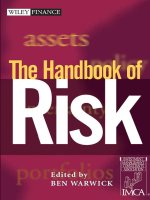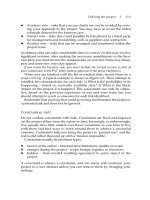The handbook of forensic psychology (4th ed)(gnv64)
Bạn đang xem bản rút gọn của tài liệu. Xem và tải ngay bản đầy đủ của tài liệu tại đây (17.97 MB, 946 trang )
The Handbook of
Forensic Psychology
The Handbook
of Forensic
Psychology
Fourth Edition
Edited by
Irving B. Weiner
Randy K. Otto
Cover design: Wiley
This book is printed on acid-free paper.
Copyright © 2013 by John Wiley & Sons, Inc. All rights reserved
Published by John Wiley & Sons, Inc., Hoboken, New Jersey
Published simultaneously in Canada
No part of this publication may be reproduced, stored in a retrieval system, or transmitted in any form or by any
means, electronic, mechanical, photocopying, recording, scanning, or otherwise, except as permitted under
Section 107 or 108 of the 1976 United States Copyright Act, without either the prior written permission of the
Publisher, or authorization through payment of the appropriate per-copy fee to the Copyright Clearance Center,
222 Rosewood Drive, Danvers, MA 01923, (978) 750-8400, fax (978) 646-8600, or on the web at
www.copyright.com. Requests to the Publisher for permission should be addressed to the Permissions
Department, John Wiley & Sons, Inc., 111 River Street, Hoboken, NJ 07030, (201) 748-6011, fax (201) 748-6008, or
online at www.wiley.com/go/permissions.
Limit of Liability/Disclaimer of Warranty: While the publisher and author have used their best efforts in
preparing this book, they make no representations or warranties with the respect to the accuracy or completeness
of the contents of this book and specifically disclaim any implied warranties of merchantability or fitness for a
particular purpose. No warranty may be created or extended by sales representatives or written sales materials.
The advice and strategies contained herein may not be suitable for your situation. You should consult with a
professional where appropriate. Neither the publisher nor the author shall be liable for damages arising herefrom.
For general information about our other products and services, please contact our Customer Care Department
within the United States at (800) 762-2974, outside the United States at (317) 572-3993 or fax (317) 572-4002.
Wiley publishes in a variety of print and electronic formats and by print-on-demand. Some material included
with standard print versions of this book may not be included in e-books or in print-on-demand. If this book
refers to media such as a CD or DVD that is not included in the version you purchased, you may download this
material at . For more information about Wiley products, visit www.wiley.com.
Library of Congress Cataloging-in-Publication Data:
Weiner, Irving B.
The handbook of forensic psychology / Irving B. Weiner, Randy K. Otto. – Fourth edition.
1 online resource.
Includes bibliographical references and index.
ISBN 978-1-118-34841-3 (cloth : alk. paper)
ISBN 978-1-118-73471-1 (ebk.)
ISBN 978-1-118-73483-4 (ebk.)
1. Forensic psychology–Handbooks, manuals, etc. I. Otto, Randy K. II. Title.
RA1148
614′ .15—dc23
2013018068
Printed in the United States of America
10 9 8 7 6 5 4 3 2 1
Contents
Preface
ix
Contributors
PART ONE
xiii
CONTEXT OF FORENSIC PSYCHOLOGY
1 History of Forensic Psychology
Curt R. Bartol and Anne M. Bartol
3
2 Defining Forensic Psychology
Randy K. Otto and James R. P. Ogloff
35
3 Accessing the Law and Legal Literature
David DeMatteo, Michael E. Keesler, and Heidi Strohmaier
57
4 Practicing Ethical Forensic Psychology
Irving B. Weiner and Allen K. Hess
85
5 Training in Forensic Psychology
Daniel A. Krauss and Bruce D. Sales
PART TWO
111
APPLYING PSYCHOLOGY TO CIVIL PROCEEDINGS
6 Conducting Child Custody and Parenting Evaluations
Philip M. Stahl
137
7 Conducting Personal Injury Evaluations
Lisa Drago Piechowski
171
8 Identifying and Treating Educational Disabilities
Daniel J. Reschly
197
9 Assessing Civil Capacities
Michele Galietta, Alexandra Garcia-Mansilla, and Barbara Stanley
219
10 Conducting Child Abuse and Neglect Evaluations
Lois O. Condie
237
v
vi
CONTENTS
PART THREE
APPLYING PSYCHOLOGY TO CRIMINAL PROCEEDINGS
11
Assessing Competency to Stand Trial
Patricia A. Zapf, Ronald Roesch, and Gianni Pirelli
281
12
Assessing Criminal Responsibility
Patricia A. Zapf, Stephen L. Golding, Ronald Roesch, and Gianni Pirelli
315
13
Specific Intent and Diminished Capacity
Charles R. Clark
353
PART FOUR
SPECIAL APPLICATIONS
14
Assessing Violence Risk
Kevin S. Douglas, Stephen D. Hart, Jennifer L. Groscup,
and Thomas R. Litwack
385
15
Psychology and Law Enforcement
Ellen M. Scrivner, David M. Corey, and Lorraine W. Greene
443
16
Evaluating and Assisting Jury Competence in Civil Cases
Jennifer K. Robbennolt, Jennifer L. Groscup, and Steven Penrod
469
17
Evaluating Eyewitness Testimony of Adults
Stephen J. Ross, Colin G. Tredoux, and Roy S. Malpass
513
18
Evaluating Eyewitness Testimony of Children
Sue D. Hobbs, Jonni L. Johnson, Gail S. Goodman,
Daniel Bederian-Gardner, Michael J. Lawler,
Ivan D. Vargas, and Macaria Mendoza
561
19
Employing Polygraph Assessment
William G. Iacono and Christopher J. Patrick
613
20
Applying Hypnosis in Forensic Contexts
Alan W. Scheflin
659
PART FIVE
COMMUNICATING EXPERT OPINIONS
21
Writing Forensic Reports
Irving B. Weiner
711
22
Testifying in Court
Randy K. Otto, Susan L. Kay, and Allen K. Hess
733
PART SIX
23
INTERVENING WITH OFFENDERS
Practicing Psychology in Correctional Settings
Paul Gendreau and Claire Goggin
759
Contents
vii
24 Treating Criminal Offenders
Robert D. Morgan, Daryl G. Kroner, Jeremy F. Mills,
and Ashley B. Batastini
795
25 Assessing and Treating Sex Offenders
W. L. Marshall, Douglas Boer, and Liam E. Marshall
839
Appendix: Specialty Guidelines for Forensic Psychology
867
Author Index
881
Subject Index
905
Preface
T
HE potential for psychologists to assist the legal system has been recognized since the early 20th century, but only within the past 50 years
has psychology begun to realize this potential in meaningful ways. This
progress has included newly developed professional organizations, such as the
American Psychology-Law Society and the International Association for Correctional and Forensic Psychology; graduate, internship, and fellowship programs
in the specialty area (listed in www.ap-ls.org/education/GraduatePrograms.php);
organizations devoted to certifying qualified practitioners, such as the American
Board of Forensic Psychology and the American Board of Police and Public Safety
Psychology; such scientific journals as Law and Human Behavior, Behavioral Sciences
and the Law, and Criminal Justice and Behavior; and books devoted to the interface of
psychology and law. This specialty area has continued to grow rapidly since the
previous edition of the Handbook of Forensic Psychology was published in 2006, with
increasing numbers of psychologists becoming involved in forensic practice and
research and a steady flow of new ideas and information becoming available.
This fourth edition of the Handbook of Forensic Psychology, like its predecessors,
aims to provide an authoritative and comprehensive resource for understanding the
theoretical foundations of forensic psychology, becoming familiar with the expanding research base in this specialty, and learning to apply forensic concepts artfully
in everyday practice. To this end, the contributors to this volume, as in the prior
three editions, are accomplished scholars and practitioners in their respective areas.
Some are prominent academicians who conduct research and offer consultation.
Others are actively engaged service providers who also make significant contributions to the literature. Several have degrees in law as well as psychology. These
authors were asked to delineate the enduring issues in an area of their specialty and
frame these issues in the light of contemporary research and prevailing conceptual
formations.
Although similar in focus and structure to previous editions, the present volume
has been substantially rewritten and updated to enhance its value. The content
and sequence of the chapters have been reframed to increase their relevance to the
practice of forensic psychology and encompass both recent research findings and
developments in statutory and case law. As testimony to the fresh perspectives in
this fourth edition, the Table of Contents identifies 48 authors and co-authors, of
whom 24 are new contributors to the Handbook.
ix
x
PREFACE
The present volume comprises six parts. Part One concerns the context of forensic
psychology and begins with chapters on the history of forensic psychology and on
defining the nature of forensic psychology. Chapter 3 then provides information
about and guidelines for accessing the legal literature. Chapter 4 alerts forensic
psychologists to ethical and legal considerations that should guide their work,
with specific attention to the American Psychological Association ethics code and
the Specialty Guidelines for Forensic Psychology. Chapter 5 describes training
models and resources in forensic psychology for faculty developing programs of
instruction and for students and general practitioners seeking specialized education
or supervised experience in forensic psychology.
Part Two comprises five chapters concerning applications of psychology in
civil proceedings. Chapter 6 addresses family law procedures and issues related
to conducting evaluations of children and their parents involved in disputed
custody. Chapter 7 discusses personal injury litigation, with particular attention
to considerations in psychological assessment. Chapter 8 reviews the impact of
recent congressional legislation on identifying and treating educational disabilities.
Chapter 9 examines issues related to the assessment of persons’ competence to execute a variety of legal rights in civil contexts. Chapter 10 concludes this section with
guidelines for conducting evaluations in cases of alleged child abuse or neglect.
Part Three deals with applying psychology in criminal proceedings and covers
three critical considerations of concern to triers-of-fact. Chapter 11 provides guidelines for assessing competence to stand trial. Chapter 12 traces the development
and current applications of the concepts of criminal responsibility and legal insanity. Chapter 13 delineates the related nuances of criminal intent and diminished
capacity.
Part Four presents information on seven special applications of forensic psychology. Chapter 14 leads off with a discussion of violence risk research and assessment,
and Chapter 15 follows with an overview of emerging roles for psychologists in law
enforcement. Chapter 16 reviews considerations related to evaluating jury decision
making and promoting juror competence. Chapters 17 and 18 review developments
related to the evaluation of testimony given by adults and children. Chapters 19
and 20 then provide accounts of the development of lie detection and hypnosis and
describe current and emerging trends in forensic uses of these procedures.
Part Five of the Handbook looks at effective communication of expert opinion in
forensic cases. Chapter 21 focuses on the essentials of writing appropriate and useful
reports, and Chapter 22 discusses the admissibility of expert testimony and key
considerations in communicating one’s work and opinions to legal decision makers.
Part Six concludes the Handbook with consideration of some important aspects
of providing services to offenders. Chapter 23 discusses principles of effective correctional rehabilitation in both prison settings and the community, and Chapter 24
provides a behind-the-bars guide to conducting psychotherapy with offenders.
Chapter 25 continues this theme with specific attention to diagnostic and treatment
Preface
xi
procedures useful in working with sexual offenders. Finally, the Appendix provides
readers with the full text of the Specialty Guidelines for Forensic Psychology.
We would like to thank our authors for their valuable contributions to this
volume, both those who revised chapters that appeared in previous editions and
those who joined us for the first time in this edition. We also want to acknowledge
with appreciation the guidance and support of the John Wiley & Sons editorial staff,
particularly Patricia Rossi, Executive Editor, and Kara Borbely, Editorial Program
Coordinator. Finally, we recognize and honor the contributions of our colleague
Allen Hess, who served as co-editor of the first three editions before his untimely
death. Readers familiar with previous editions of the Handbook will recognize his
fingerprints on this edition as well.
IRVING B. WEINER
RANDY K. OTTO
Contributors
Anne M. Bartol, PhD
Bartol Consulting and Writing
Glenville, New York
Curt R. Bartol, PhD
Bartol Consulting and Writing
Glenville, New York
Ashley B. Batastini, MS
Department of Psychology
Texas Tech University
Lubbock, Texas
Daniel Bederian-Gardner, MA
Department of Psychology
University of California
Davis, California
Douglas Boer, PhD
Department of Psychology
University of Waikato
Hamilton, New Zealand
Charles R. Clark, PhD, ABPP
Independent Practice
Ann Arbor, Michigan
Lois O. Condie, PhD, ABPP
Department of Neurology
Harvard Medical School
Boston, Massachusetts
David M. Corey, PhD, ABPP
Independent Practice
Lake Oswego, Oregon
David DeMatteo, JD, PhD
Department of Psychology
Earle Mack School of Law
Drexel University
Philadelphia, Pennsylvania
Kevin S. Douglas, LLB, PhD
Department of Psychology
Simon Fraser University
Burnaby, British Columbia, Canada
Michele Galietta, PhD
John Jay College of Criminal Justice
City University of New York
New York, New York
Alexandra R. Garcia-Mansilla, PhD
Queens TAC Mental Health Jail
Diversion Program
New York, New York
Paul Gendreau, PhD
Department of Psychology
University of New Brunswick
Saint John, New Brunswick,
Canada
Claire Goggin, PhD
Department of Criminology and
Criminal Justice
St. Thomas University
Fredericton, New Brunswick,
Canada
xiii
xiv
CONTRIBUTORS
Stephen L. Golding, PhD, ABPP
Department of Psychology
University of Utah
Salt Lake City, Utah
Gail S. Goodman, PhD
Department of Psychology
University of California
Davis, California
Lorraine W. Greene, PhD, ABPP
University Counseling Center
Tennessee State University
Nashville, Tennessee
Jennifer L. Groscup, JD, PhD
Department of Psychology
Scripps College
Claremont, California
Stephen D. Hart, PhD
Department of Psychology
Simon Fraser University
Burnaby, British Columbia, Canada
Allen K. Hess, PhD
Department of Psychology
Auburn University at Montgomery
Montgomery, Alabama
Sue D. Hobbs, MA
Department of Psychology
University of California
Davis, California
William G. Iacono, PhD
Department of Psychology
University of Minnesota
Minneapolis, Minnesota
Jonni L. Johnson, MA
Department of Psychology
University of California
Davis, California
Susan L. Kay, JD
Vanderbilt University Law School
Nashville, Tennessee
Michael E. Keesler, JD, MS
Department of Psychology
Drexel University
Philadelphia, Pennsylvania
Daniel A Krauss, JD, PhD, ABPP
Department of Psychology
Claremont McKenna College
Claremont, California
Daryl G. Kroner, PhD
Department of Criminology &
Criminal Justice
Southern Illinois University
Carbondale, Illinois
Michael J. Lawler, PhD
School of Health Sciences
University of South Dakota
Vermillion, South Dakota
Thomas R. Litwack, PhD, JD
John Jay College of Criminal Justice
City University of New York
New York, New York
Roy S. Malpass, PhD
Department of Psychology
University of Texas at El Paso
El Paso, Texas
Liam E. Marshall, PhD
Rockwood Psychological Services
Kingston, Ontario, Canada
W. L. Marshall, PhD
Rockwood Psychological Services
Kingston, Ontario, Canada
Contributors
Macaria Mendoza, MA
Center for Public Policy Research
University of California
Davis, California
Gianni Pirelli, PhD
Department of Psychology
Greystone Park Psychiatric Hospital
Morris Plains, New Jersey
Jeremy F. Mills, PhD
Department of Psychology
Carleton University
Ottawa, Ontario, Canada
Daniel J. Reschly, PhD
Peabody College of Education and
Human Development
Vanderbilt University
Nashville, Tennessee
Robert D. Morgan, PhD
Department of Psychology
Texas Tech University
Lubbock, Texas
James R. P. Ogloff, JD, PhD
School of Psychology, Psychiatry,
and Psychological Medicine
Monash University and Institute of
Forensic Mental Health
Victoria, Australia
Randy K. Otto, PhD, ABPP
Department of Mental Health Law
and Policy
University of South Florida
Tampa, Florida
Christopher J. Patrick, PhD
Department of Psychology
Florida State University
Tallahassee, Florida
Steven Penrod, JD, PhD
John Jay College of Criminal Justice
City University of New York
New York, New York
Lisa Drago Piechowski, PhD, ABPP
Department of Clinical Psychology
American School of Professional
Psychology
Washington, DC
Jennifer K. Robbennolt, JD, PhD
College of Law
University of Illinois
Champaign, Illinois
Ronald Roesch, PhD
Department of Psychology
Simon Fraser University
Burnaby, British Columbia, Canada
Stephen J. Ross, PhD
Interdisciplinary Arts and Sciences
University of Washington, Tacoma
Tacoma, Washington
Bruce D. Sales, PhD, JD
Department of Criminal Justice
University of Indiana
Bloomington, Indiana
Alan W. Scheflin, LLM
Santa Clara University School of Law
Santa Clara, California
Ellen M. Scrivner, PhD
Executive Fellow
Police Foundation
Washington, DC
Philip M. Stahl, PhD, ABPP
Independent Practice
Queen Creek, Arizona
xv
xvi
CONTRIBUTORS
Barbara Stanley, PhD
Department of Neuroscience
New York State Psychiatric
Institute
New York, New York
Ivan D. Vargas, JD
Center for Public Policy Research
University of California
Davis, California
Heidi Strohmaier
Department of Psychology
Drexel University
Philadelphia, Pennsylvania
Irving B. Weiner, PhD, ABPP
Department of Psychiatry and
Neurosciences
University of South Florida
Tampa, Florida
Colin G. Tredoux, PhD
Department of Psychology
University of Cape Town
Cape Town, South Africa
Patricia A. Zapf, PhD
John Jay College of Criminal Justice
City University of New York
New York, New York
PART ONE
CONTEXT OF FORENSIC
PSYCHOLOGY
CHAPTER 1
History of Forensic Psychology
CURT R. BARTOL AND ANNE M. BARTOL
I
N the course of writing this chapter over four editions of this Handbook, we have
learned a few lessons. In the first edition, we asserted that psychologists do not
care about the history of their profession but are instead drawn to contemporary
issues and theories. We learned that this was a simplistic generalization, so in
subsequent editions we acknowledged that our initial statement had been rash.
Psychologists (perhaps most of them) do care about history, as is apparent from
numerous articles published in professional journals reviewing historical trends,
the continuing publication of a journal devoted to the history of psychology, and
special interest divisions of professional organizations, such as Division 26, Society
for the History of Psychology, of the American Psychological Association (APA).
We have also learned that there is some danger in proclaiming an event or a person
a historic “first” or a “father,” because these proclamations may be challenged,
usually with kindness but not always with good humor.
Psychology, like other disciplines, needs historical insights. It needs to understand
whence it came in order to assess where it is going. A perusal of journals and books
published at the turn of the 20th century, for example, may spark interest in a concept
long forgotten or a predecessor whose theories and research deserve to be revisited.
Yet delving into early works reminds us of false starts and the occasional damage
they did, such as the work of Henry H. Goddard (1914) on feeblemindedness during
the early 1900s and the self-promotion of Hugo Munsterberg.
However, we have
¨
also learned that hindsight is imperfect; people are sometimes overlooked, and the
historical discoveries may be incomplete. We thus approach this chapter once again
with humility. To paraphrase the phrase that “journalism is the first rough draft of
history,” we say here that this chapter is our fourth rough draft of the history of
forensic psychology, with emphasis on its American origins.
In these early years of the 21st century, forensic psychology remains a young
branch of applied psychology, having been recognized by the APA as a specialty
in 2001 and recertified in 2008. Even before that, in 1991, Specialty Guidelines for
3
4
CONTEXT OF FORENSIC PSYCHOLOGY
Forensic Psychologists (Committee on Ethical Guidelines for Forensic Psychologists
[hereafter Committee], 1991) were adopted by the American Psychology–Law
Society, which is Division 41 of the APA. These Guidelines were recently revised,
renamed Specialty Guidelines for Forensic Psychology (APA, 2013), and accepted
by the APA Council of Representatives. (The Specialty Guidelines are reprinted as
the appendix to this volume with permission of the APA.) Interestingly, although
forensic psychology was initially viewed as primarily clinical in nature—such as
by providing assessments to the courts—its scope has broadened to encompass the
practice of psychology as it provides expertise to the law in a very wide range of
contexts (see APA, 2013; Committee, 1991).
This broad view of forensic psychology was not always supported. According to
Ronald Roesch, for example (cited in Brigham, 1999, p. 279), “Most psychologists
define the area more narrowly to refer to clinical psychologists who are engaged
in clinical practice within the legal system.” A few years later, Brigham and Grisso
(2003) modified this somewhat, noting “Many psychologists define forensic psychology more narrowly to refer to clinical psychologists who are engaged in clinical
practice within the legal system. The distinction here is between psychologists who
bring scientific information to the courts for their consideration in cases and psychologists who evaluate individuals and testify about them in reference to a legal
question” (p. 392, emphasis added). In recognizing forensic psychology as a specialty in 2001, the APA itself adopted the narrow approach, to include “the primarily
clinical aspects of forensic assessment, treatment, and consultation” (Otto & Heilbrun, 2002, p. 8). However, as noted, the Specialty Guidelines take a broader view.
In this chapter, forensic psychology is being viewed broadly. It is both (1) the
research endeavor that examines aspects of human behavior directly related to the
legal process (e.g., eyewitness memory and testimony, jury decision making, and
criminal behavior) and (2) the professional practice of psychology within or in consultation with a legal system that encompasses both criminal and civil law and the
numerous areas where they intersect. Therefore, the term forensic psychology refers
broadly to the production of psychological knowledge and its application to the civil
and criminal justice systems. It includes activities as varied as these: courtroom testimony, child custody evaluations, law enforcement candidate screening, treatment
of offenders in correctional facilities, assessment of plaintiffs with disability claims,
research and theory building in the area of criminal behavior, and the design and
implementation of intervention and prevention programs for youthful offenders.
A review of the table of contents of this Handbook indicates a similarly broad focus.
In the pages to follow, after an introductory section covering seminal contributions, we review developments in four major areas of forensic psychology: legal
psychology, correctional psychology, police psychology, and criminal psychology.
Readers will undoubtedly recognize that there is considerable overlap in these
categories and in the subheadings. Correctional psychology, for example, presupposes some understanding of criminal psychology. Assessment, which we cover
under legal psychology, is an essential tool of the trade for psychologists, and it
History of Forensic Psychology
5
underlies all practice. Nonetheless, for purposes of identifying historical trends and
landmarks, discussion of these four distinctive areas is warranted.
We focus on forensic psychology rather than forensic psychiatry, which has its
own well-documented and rich history, probably centered on the early work of Isaac
Ray, who is considered by some the father of forensic psychiatry (Brigham & Grisso,
2003). We also do not delve into the origins of the sociology of law, referred to as
sociological jurisprudence, or the legal realism movement within the law itself. This
movement, born during the first third of the 20th century, advocated a partnership
between the law and the social sciences (Ogloff, Tomkins, & Bersoff, 1996).
In addition, we emphasize the work of forensic psychologists in the United States
and, to a lesser extent, Canada,1 although we give due recognition to the work of
European psychologists, who dominated the field prior to World War I. We review
the achievements of psychologists from the end of the 19th century and extend our
discussion into the 1970s, when forensic psychology came of age (Loh, 1981). The
reader interested in more detail about the issues and individuals discussed might
check landmark summaries of psychology and law published by Whipple (1909,
1910, 1911, 1912, 1913, 1914, 1915, 1917), Hutchins and Slesinger (1929), Louisell
(1955, 1957), Tapp (1976), Loh (1981), and Monahan and Loftus (1982). More recently,
Brigham and Grisso (2003) and Mulberger
(2009) have published historical pieces
¨
on this topic, the latter with a strong emphasis on German influences. On the whole,
however, developments from the 1980s forward are addressed in the works of other
contributors to this Handbook.
LEGAL PSYCHOLOGY
Legal psychology refers to psychological theory, research, and practice directly pertinent to the law and legal issues. It focuses on psycholegal research and contacts with
judges, lawyers, and other law-related professionals in a wide range of contexts. The
origins of legal psychology can be traced to the work of experimental psychologists
in Europe in the 19th century, particularly in relation to the psychology of testimony (Mulberger,
2009; Sporer, 1982, 2008) and most particularly to the testimony
¨
of children, whose memory of events was considered unreliable (Lipmann, 1911).
We discuss this work shortly.
U.S. ORIGINS
Do chestnut or oak trees lose their leaves earlier in autumn? Do horses in the field
stand with head or tail to the wind? In which direction do the seeds of an apple point?
What was the weather one week ago today?
When J. McKeen Cattell posed these questions to 56 college students at Columbia
University in March 1893, he was probably conducting one of the first American
1. We are grateful to Dr. Craig Bennell, Department of Psychology, Carleton University, for
recommending additional readings on the history of forensic psychology in Canada.
6
CONTEXT OF FORENSIC PSYCHOLOGY
studies, albeit an informal one, on the psychology of testimony. The questions he
asked his students were similar to those that “might naturally be asked in a court of
justice” (Cattell, 1895, p. 761). His subjects were allowed 30 seconds to consider their
answers, then told to write their responses and indicate their degree of confidence
in each answer.
When Cattell conducted his informal and preliminary study, it was reasonably
well established that eyewitness accounts of events were unreliable and incomplete.
As we will see shortly, both French and German psychologists were familiar with the
powerful influence of suggestion over sensation and perception, having conducted
substantial research in these areas. The specific conditions under which testimony
was inaccurate were not known, however. Cattell (1895) noted: “An unscrupulous
attorney can discredit the statements of a truthful witness by cunningly selected
questions. The jury, or at least the judge, should know how far errors in recollection
are normal and how they vary under different conditions” (p. 761). But Cattell
himself was surprised at both the degree of inaccuracy he uncovered and the wide
range of individual differences in the levels of confidence expressed by the students.
Answers to the weather question, for example, were “equally distributed over all
kinds of weather which are possible at the beginning of March” (p. 761). Some
students were nearly always sure they were correct, even when they were not,
while others were consistently uncertain and hesitant in their answers, even when
they were correct.
Cattell’s study probably was the genesis of modern forensic psychology in the
United States, because it sparked the interest of other researchers in the psychology
of testimony, which remains to this day a dominant research interest among legal
psychologists. Joseph Jastrow immediately replicated Cattell’s “experiment” at the
University of Wisconsin and obtained similar results (Bolton, 1896). Aside from
this brief flirtation, however, American psychologists did not immediately embrace
the study of legal issues. Psychologists in Europe seemed more intrigued—they
had long been interested in the psychological concepts involved. First, Alfred Binet
(1900) replicated Cattell’s project in France. In addition, he summarized relevant
experiments on the psychology of testimony that were being conducted in Europe,
and he eventually called for a “science psycho-judiciaire” (Binet, 1905; Binet &
Clarparede, 1906).
EUROPEAN ORIGINS
Most significant for the historical development of forensic psychology was the
apparent fascination Cattell’s experiment and Binet’s work held for (Louis) William
Stern (1902, 1910, 1939), who had received his doctorate in psychology at the
University of Berlin under the tutelage of Hermann Ebbinghaus. In 1901, Stern
collaborated with the criminologist F. v. Liszt in an attempt to lend realism to
the Cattell design. Stern and Liszt conducted a “reality experiment” in a law
class, staging a bogus quarrel between two students over a scientific controversy.
History of Forensic Psychology
7
As Stern later recounted it, the argument accelerated until one student drew a
revolver (Stern, 1939). At this point, the professor intervened and asked for written
and oral reports from the class about aspects of the dispute. Although the witnesses
were law students who, Stern asserted, should have known the pitfalls of testifying,
none could give a faultless report. The number of errors per individual ranged from
4 to 12. Moreover, the researchers found that inaccuracies increased with respect to
the second half of the scenario, when excitement and tension were at their peak.
They concluded—tentatively—that “affective reactions inhibit exact observation
and reliable remembrance” (Stern, 1939, p. 11).
By his own account, Stern (1939) was more interested in basic research than its
application. “Indeed, when I began in 1901 to examine the correctness of recollection
among my students, I was determined by theoretical interests in the realm of memory rather than by any practical considerations. Yet once confronted with the results,
I realized the importance of this research beyond the borders of mere academic
psychology” (p. 4).
Throughout that first decade of the 20th century, Stern was an active researcher
in the psychology of testimony. He also helped establish and edited the first journal
on the psychology of testimony, Betrage zur Psychologie der Aussage (Contributions to
the Psychology of Testimony), which was published in Leipzig. The journal was superseded in 1907 by the much broader Zeitschrift fur
¨ Angewande Psychologie (Journal of
Applied Psychology), edited by Stern and his colleague Otto Lipmann. In a cautionary
note about his research, Stern stressed that most witnesses did not intentionally
falsify their reports. Rather, the subtle and common problem created was one of
unintentional falsification: “Subjective sincerity does not guarantee objective truthfulness,” he wrote (1939, p. 13). In his research, Stern concluded among other things
that: (1) leading and suggestive questions contaminate the accuracy of eyewitness
accounts of critical events; (2) there are important differences between adult and
child witnesses; (3) lineups are of limited value when the members are not matched
for age and physical appearance; and (4) interceding events between an initial
event and its recall can have drastic effects on memory. Therefore, modern forensic
psychology began as legal psychology with empirical research on the psychology
of testimony.
During these early years, European psychologists interacted much more regularly
with the law than their American counterparts did. Despite the fact that Stern and
Binet, for example, did not initially intend that their research on suggestibility and
reliability of observation be applied to the law, they eventually did recommend
such an application. Thus European, particularly German, psychologists conducted
experimental research, lectured, and consulted with jurists, particularly in the latter
half of the 19th century and into the 20th (Mulberger,
2009; Sporer, 1982).
¨
Courtroom Testimony. Pinpointing the origins of courtroom testimony by psychologists in Europe is not easy. Sources differ, often depending on the nature of the
forum (e.g., civil versus criminal court, preliminary hearing versus trial) or its









